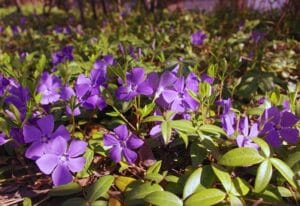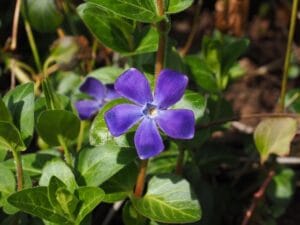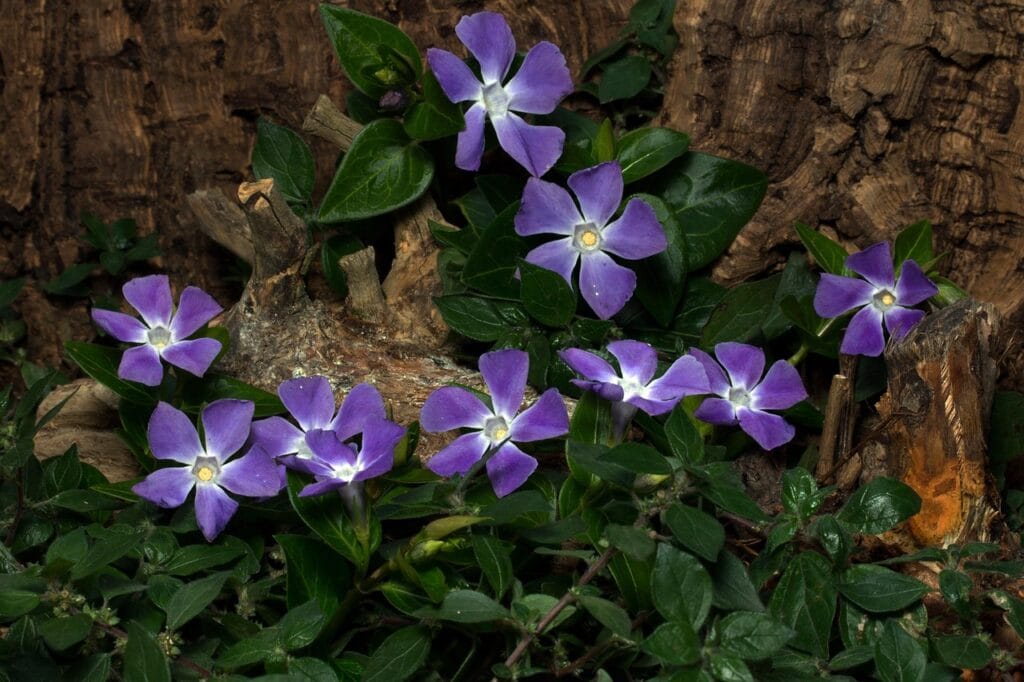Introduction
Vinca Minor, also known as common periwinkle, creeping myrtle, or dwarf periwinkle, is a popular evergreen ground cover known for its beautiful violet-blue flowers and glossy green leaves. With its low-maintenance nature and fast-spreading habit, Vinca Minor is a favorite among gardeners seeking to beautify shady spots in the garden or add greenery indoors.
If you’re looking to grow and care for Vinca Minor at home, whether in the garden or containers, this guide will walk you through everything you need to know for healthy, vibrant plants.

What is Vinca Minor?
Vinca Minor is a low-growing perennial plant that forms a dense mat of foliage and blooms small, five-petaled flowers in shades of purple, blue, or white. Native to Europe, it’s now grown widely across North America for its hardiness, drought-tolerance, and ability to thrive in partial to full shade.
- Common Name: Periwinkle, Creeping Myrtle
- Botanical Name: Vinca minor
- Type: Evergreen ground cover
- Height: 4–6 inches
- Spread: Up to 18 inches and beyond
- USDA Zones: 4–9
- Light: Partial shade to full shade
- Soil: Well-draining, moderately fertile
- Bloom Time: Spring to early summer, occasional blooms year-round in mild climates
- Toxicity: Toxic to pets if ingested
Light Requirements
Vinca Minor thrives in partial to full shade, making it an ideal plant for low-light areas in your garden. While it can tolerate some morning sun, especially in cooler climates, too much direct sunlight may scorch its leaves. In hot regions, plant it under trees or shaded structures. Indoors, place the pot near a bright window with indirect light to ensure healthy foliage and vibrant growth without sun damage.
- Under trees
- Along shaded walkways
- North-facing garden beds
- Indoor ne, ar bright, filtered light (for potted Vinca)

Soil Conditions
Vinca Minor thrives in well-draining, moderately fertile soil. It prefers slightly acidic to neutral pH levels (around 6.0 to 7.0) and performs best in loose, organic-rich soil. While tolerant of poor soil, avoid heavy clay or overly wet areas, which can lead to root rot. Improve drainage by adding compost or sand. Ideal for shaded areas, Vinca Minor adapts easily, making it a low-maintenance choice for diverse soil conditions.
- Mix compost or leaf mold into heavy soils
- Avoid clay-heavy soil without amending it
Watering
Watering Vinca Minor correctly is essential for healthy growth. Keep the soil consistently moist but not soggy, especially during the first growing season. Once established, the plant becomes fairly drought-tolerant. Water deeply once a week during dry periods. Avoid overwatering, as soggy soil can lead to root rot. In winter, reduce watering frequency. For potted Vinca Minor, water when the top inch of soil feels dry to the touch.
- Keep soil lightly moist during spring and summer
- Reduce watering during fall and winter
- Never let the soil become soggy—root rot can occur
Fertilizing
Fertilizing Vinca Minor is simple and enhances its lush foliage and flower production. Apply a balanced, slow-release fertilizer (such as 10-10-10) in early spring to encourage healthy growth. For extra blooms, you can feed again lightly in midsummer. Avoid over-fertilizing, as too much nitrogen may reduce flowering. Always water the plant after applying fertilizer to help nutrients absorb into the soil and prevent root burn.
- Apply a balanced slow-release fertilizer (10-10-10) in early spring
- Optional: Feed again in midsummer if growth seems slow

Pruning and Maintenance
Pruning and maintaining Vinca Minor is essential to keep its growth in check and promote a healthy, tidy appearance. Trim back long runners after flowering to control spread and prevent it from invading other garden areas. In early spring, remove any dead or leggy stems to encourage new growth. Every few years, thin out dense patches to improve airflow and reduce disease risk, ensuring your periwinkle stays vibrant and manageable.
- Trim runners after flowering to keep them in bounds
- Cut back dead or leggy stems in early spring
- Thin the plant every few years to improve airflow
Propagation: Cuttings and Division
Propagating Vinca Minor is simple and cost-effective, allowing you to expand your ground cover or share with others. The two easiest methods are stem cuttings and division.
Cuttings
Take 4–6-inch cuttings from healthy, non-flowering stems in spring or summer. Remove the lower leaves and dip the cut end in rooting hormone. Plant the cutting in a pot with moist, well-draining soil and place it in indirect light. Keep the soil consistently moist, and roots should develop within 3–4 weeks.
Division
In early spring or fall, gently dig up a clump of Vinca Minor. Separate rooted sections using your hands or a clean knife. Replant each section at the same depth in prepared soil, and water thoroughly. This method is especially useful for managing overgrown patches while creating new plants for other areas.

Vinca minor ground cover
Vinca Minor is a popular ground cover plant known for its lush, trailing foliage and vibrant violet-blue flowers. It spreads quickly, forming a dense, evergreen mat that effectively suppresses weeds and prevents soil erosion. Ideal for shady areas, Vinca Minor thrives under trees, along pathways, and on slopes. Its low-maintenance nature and year-round greenery make it a favorite choice for gardeners seeking a beautiful, easy-care solution for covering bare ground.
Is Vinca Minor Safe for Pets?
Vinca Minor is not safe for pets. It contains alkaloids that can be toxic to cats, dogs, and small animals if ingested, causing symptoms like vomiting, diarrhea, and low blood pressure. Keep this plant out of reach of curious pets or consider pet-safe alternatives for your garden or indoor space.
Container Growing Vinca Minor
Yes! Vinca Minor can be grown in hanging baskets or containers, especially on shaded patios or indoor areas with bright, indirect light.
- Use a container with good drainage
- Choose a well-draining, light potting mix
- Water when the top inch of soil feels dry
- Prune regularly to control the spread

Winter Care
Vinca Minor is a hardy evergreen that generally survives winter in USDA zones 4–9. To protect it during colder months, apply a 2–3 inch mulch layer around the base to insulate roots and prevent frost damage. For container-grown plants, move them to a sheltered area or indoors. Reduce watering in winter, as the plant requires less moisture, and overly wet soil can lead to root rot in cold conditions.
Common Pests & Problems
Vinca Minor is relatively pest-free, but occasionally, you may see:
- Aphids – spray with neem oil or soapy water
- Slugs/Snails – handpick or use slug bait in shady gardens
- Leaf spot or root rot – improve airflow and avoid overwatering
Companion Planting Ideas
Pair Vinca Minor with other shade-loving plants to create a beautiful and diverse garden bed:
- Hostas
- Ferns
- Astilbes
- Coral bells
- Bleeding heart

Vinca minor
Vinca minor, commonly known as periwinkle or creeping myrtle, is a low-growing, evergreen ground cover plant valued for its vibrant blue-violet flowers and glossy green leaves. Ideal for shady gardens, it spreads quickly to form dense mats that suppress weeds and prevent soil erosion. Drought-tolerant and low-maintenance, Vinca minor is perfect for borders, under trees, or slopes. However, it can be invasive if not managed properly in some regions.
Where to Use Vinca Minor at Home
- Ground cover for shady borders and slopes
- Erosion control on hillsides
- Container gardening for shaded balconies
- Living mulch under trees
- Edging plant for shaded walkways
Expert Tips for Thriving Vinca Minor
Don’t plant near native areas—it may spread aggressively
Water deeply during dry spells in the first year
Trim aggressively if it gets invasive
Monitor pets to avoid accidental ingestion
Use edging barriers to control the spread in garden beds
FAQ
Q1: Can Vinca Minor grow in full sun?
A1: It can tolerate some sun, but it prefers partial to full shade for best growth.
Q2: How fast does Vinca Minor spread?
A2: It spreads quickly—up to 12–18 inches per year under ideal conditions.
Q3: Is Vinca Minor invasive?
A3: Yes, in some regions it is considered invasive. Use edging and regular pruning to manage it.
Q4: How often should I water Vinca Minor?
A4: Water once a week or when the top inch of soil is dry, especially during the first year.
Q5: Can I grow Vinca Minor indoors?
A5: Yes, it grows well in containers indoors with bright, indirect light and regular pruning.
Conclusion
Vinca Minor is a reliable, low-maintenance plant that brings color and life to even the shadiest corners of your home or garden. With just a bit of care, this beautiful ground cover will reward you with evergreen foliage and charming blooms season after season.

